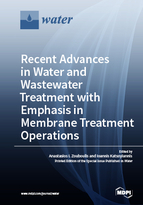Recent Advances in Water and Wastewater Treatment with Emphasis in Membrane Treatment Operations
A special issue of Water (ISSN 2073-4441). This special issue belongs to the section "Wastewater Treatment and Reuse".
Deadline for manuscript submissions: closed (30 September 2018) | Viewed by 76289
Special Issue Editors
Interests: separation sciences and related technologies; wastewater/water treatment; membrane fouling; aerobic/anaerobic digestion; recovery/removal of metals from liquid waste streams; physicochemical methods for the treatment of contaminated water sources or of wastewaters, biological/aerobic or anaerobic treatment methods; combinations of biological and physicochemical methods; treatment/recycling issues of toxic industrial solid wastes; hydrometallurgical; physico-chemical (solidification/stabilization); thermal (vitrification), or appropriate combinations of treatment processes; carbon capture utilization and storage (CCUS)
Special Issues, Collections and Topics in MDPI journals
Interests: water treatment processes for removal of inorganic and organic contaminants: role of sorption and oxidation in contaminant removal; design and application of novel sorbents; oxidation processes in drinking water treatment; wastewater treatment and reuse; solid waste management
Special Issues, Collections and Topics in MDPI journals
Special Issue Information
Dear Colleagues,
Worldwide, an estimated 800 million people remain without access to an improved source of drinking water and in parallel global water demand for manufacturing is expected to increase by 400% between 2000 and 2050. Although between 2001 and 2010 more than one billion Euros were invested by the European Commission to tackle this problem, it is evident that the Millennium Development Goals targets have not been fully met by 2015. In September 2015, the United Nations adopted the sustainable development goals for 2030 and one of them is to ensure availability and sustainable management of water and sanitation for all. Given the time frame of only 15 years, the achievement of such goals requires immediate action and translation of knowledge into practice.
The proposed Special Issue intends to bring together recent research findings from renowned scientists in this field. The aim is to assemble contributions on advanced technologies applied to the treatment of wastewater and drinking water, with emphasis on novel membrane treatment. We seek contributions that analyze water treatment systems with the objective of modelling, designing and optimizing the different processes.
Prof. Dr. Anastasios I. Zoubouli
Assist. Prof. Dr. Ioannis Katsogiannis
Guest Editors
Manuscript Submission Information
Manuscripts should be submitted online at www.mdpi.com by registering and logging in to this website. Once you are registered, click here to go to the submission form. Manuscripts can be submitted until the deadline. All submissions that pass pre-check are peer-reviewed. Accepted papers will be published continuously in the journal (as soon as accepted) and will be listed together on the special issue website. Research articles, review articles as well as short communications are invited. For planned papers, a title and short abstract (about 100 words) can be sent to the Editorial Office for announcement on this website.
Submitted manuscripts should not have been published previously, nor be under consideration for publication elsewhere (except conference proceedings papers). All manuscripts are thoroughly refereed through a single-blind peer-review process. A guide for authors and other relevant information for submission of manuscripts is available on the Instructions for Authors page. Water is an international peer-reviewed open access semimonthly journal published by MDPI.
Please visit the Instructions for Authors page before submitting a manuscript. The Article Processing Charge (APC) for publication in this open access journal is 2600 CHF (Swiss Francs). Submitted papers should be well formatted and use good English. Authors may use MDPI's English editing service prior to publication or during author revisions.
Keywords
- Novel techniques for water and wastewater treatment.
- Innovate methods for water analysis and water quality monitoring, specifically those involved to tackle emergencies.
- Development and applications of different materials (polymeric, inorganic) for membrane water and wastewater treatment
- Optimization of the applied treatment processes trains.
- Reuse of treated water and its environmental impact.
- Contaminants in water and wastewater.
- Biological and physico-chemical water and wastewater treatment.
- Zero liquid discharge.
- Brine treatment.







